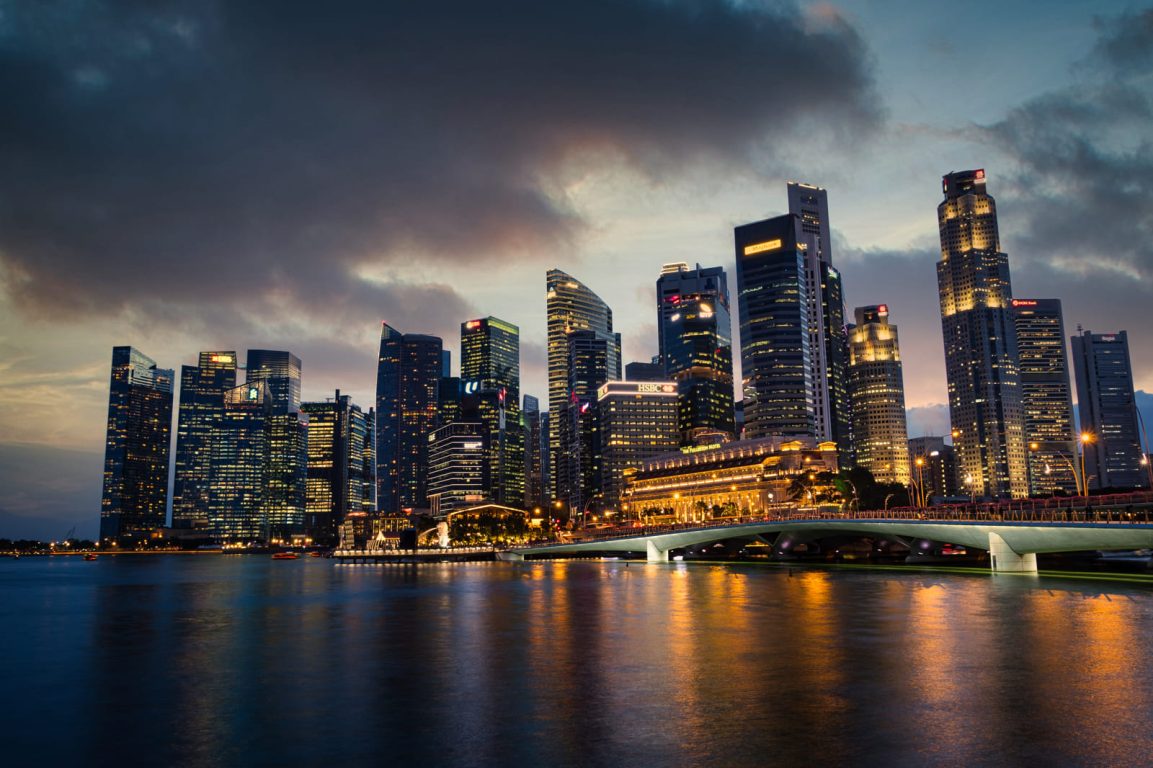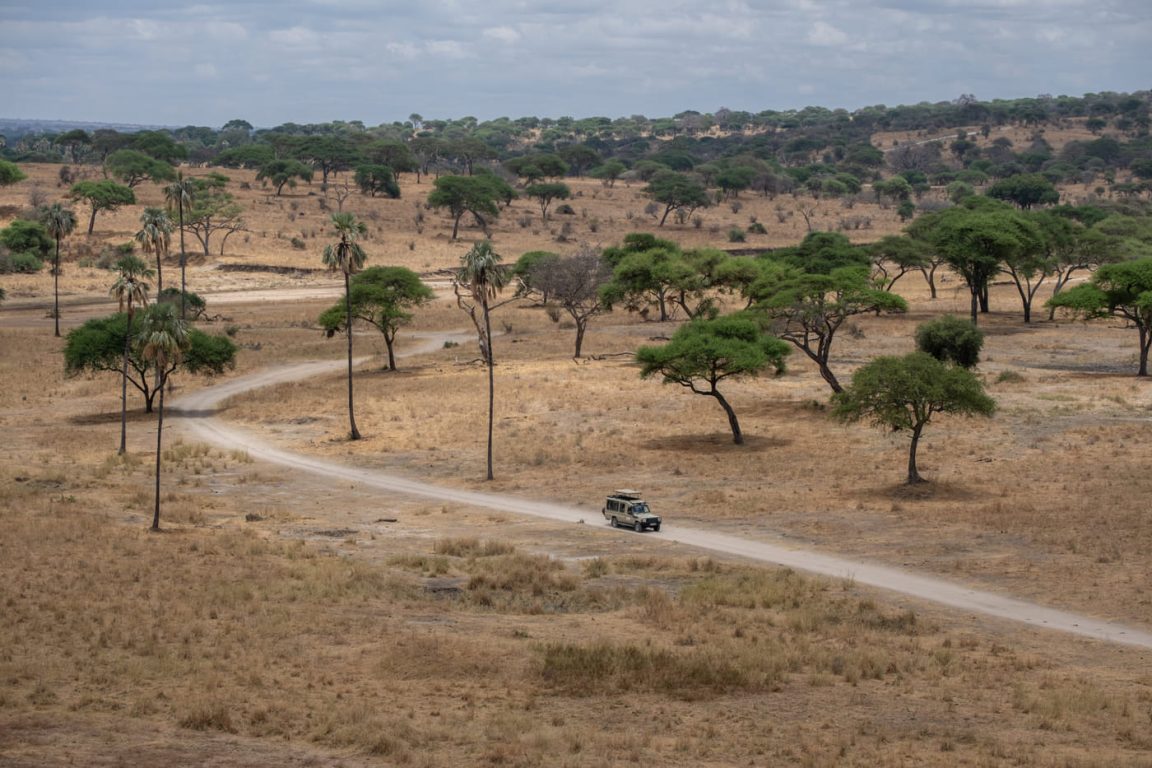Are you planning a trip to Norway and want to make sure you’re travelling in an eco-friendly way? Look no further than this. In this article, we will provide an eco-friendly itinerary in Norway, designed to showcase the best of Norway’s stunning natural landscapes while minimizing your impact on the environment.
This Scandinavian country is a perfect destination for eco-conscious travellers who want to explore the great outdoors without harming the environment. As you may know, Norway is a huge country, so on this trip, we were mainly focused on exploring the fjords area.
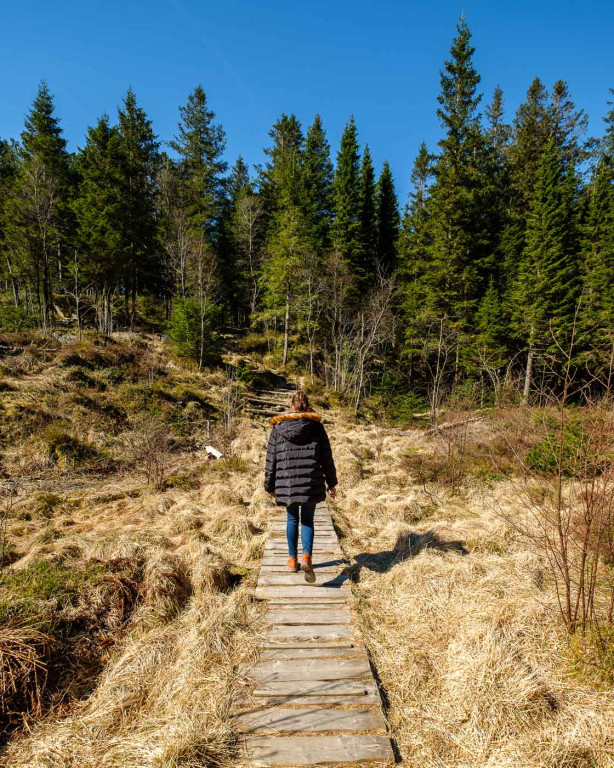


From the picturesque city of Bergen to the breathtaking Norwegian fjords, this itinerary takes you on a journey through some of Norway’s most beautiful destinations. You’ll have the opportunity to hike in national parks, spot wildlife in their natural habitats, and learn about Norwegian culture and history along the way.
So pack your bags, grab your hiking boots, and get ready for an unforgettable eco-friendly adventure in Norway!
Bergen
Our eco-friendly itinerary in Norway begins in the charming city of Bergen. Bergen is known for its colourful wooden houses, bustling fish market, and stunning views of the surrounding mountains and fjords.
To start your day, grab a cup of locally roasted coffee, the locals love to take breakfast outside, and we saw many people enjoying the early sun.
We then took a ride on the Floibanen funicular, which takes you up to the top of Mount Floyen for stunning views of the city and surrounding fjords. Norway uses NOK as its currency, so the ticket costs 85 NOK per person, one way (approx. 7,30€), you can buy it online or there at the ticket office. For the opening hours of the funicular check here, because it depends on the season.

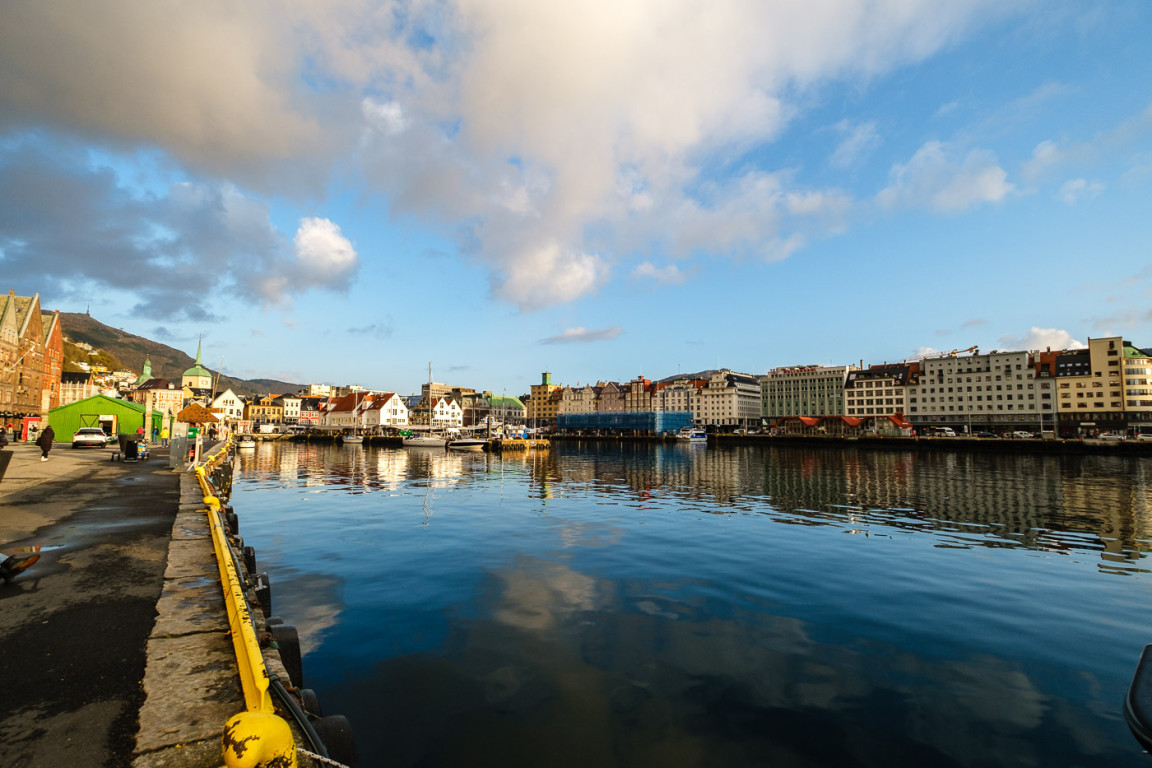
Once you reach the upper station, there are many trails you can do it. We didn’t have much time, so our option was to do a really nice walk to the nearby lake, Skomakerdiket. If you have time, you can try the Rundemanen hiking trail (one of Bergen’s seven mountains).
After taking in the panoramic vistas, we head back down to the city for a delicious lunch at Trekroneren. It is 1 hour to get back if you don’t want to use the funicular.
This iconic hot dog stand has been serving up tasty treats for over 60 years, and it’s a favourite among locals and visitors alike. Their hot dogs are made from locally sourced ingredients and come topped with classic Norwegian toppings like crispy onions and tangy mustard.
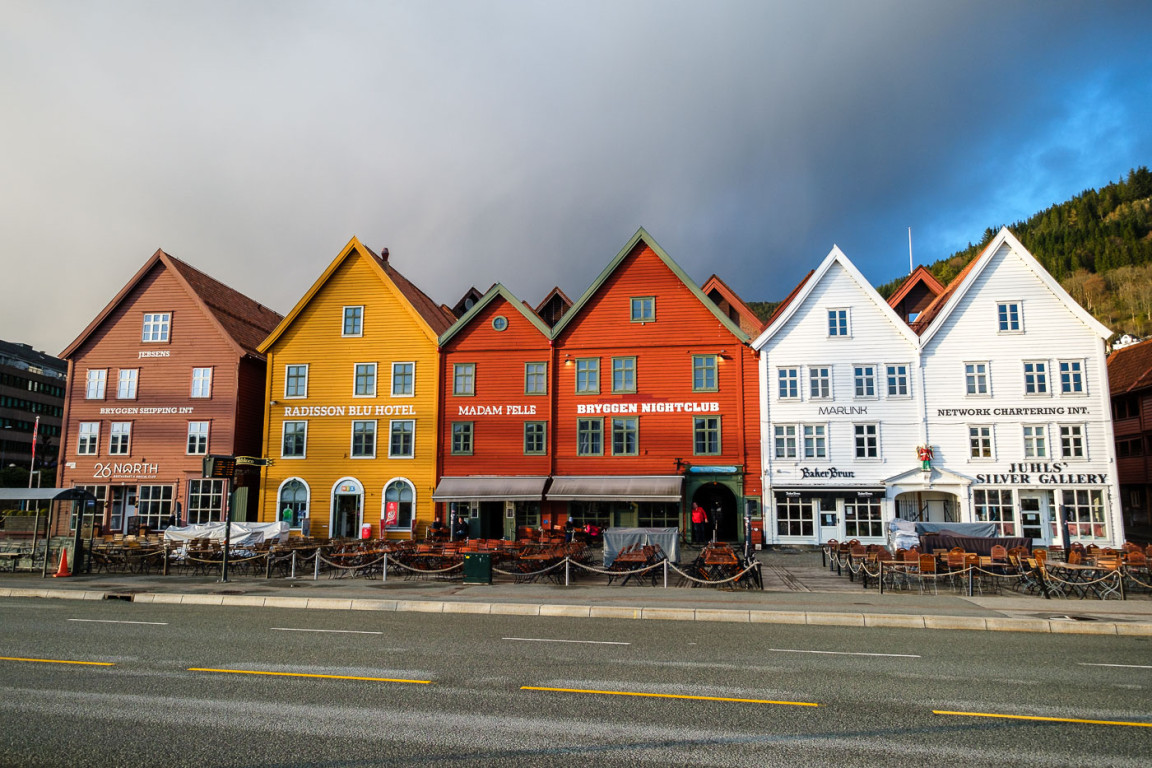
In the afternoon we headed to the Bergen Fish Market and sample some of Norway’s famous seafood, caught fresh from the nearby fjords. No trip is complete in Bergen without strolling through the streets of the historic Bryggen district, a UNESCO World Heritage Site.
Bergen to Olden
The next day of our eco-friendly itinerary in Norway, we’ll embark on a picturesque journey from Bergen to the charming village of Olden, known for its stunning natural landscapes and proximity to the Briksdalsbreen glacier.
As we rent a car in Bergen, it was a good option to drive from Bergen to Olden. This gives you the flexibility to stop at various points of interest along the way and take in the magnificent scenery at your own pace. The journey takes approximately four hours, but be sure to check the road conditions and plan for possible delays.
Also, you need to do some ferry crossings in Norway. But, don’t worry this is so simple. At the time we rent the car, we were asked to pay block a feed from our credit card for tolls and ferries (they only take the money for the exact amount at the end of the trip). To cross by ferry we only need to show up at the place, wait in line (they have marks on the street), enter the ferry with the car and disembark at the other side. Once inside the ferry, you can get out of the car, enjoy the view, and have some hot drinks inside.
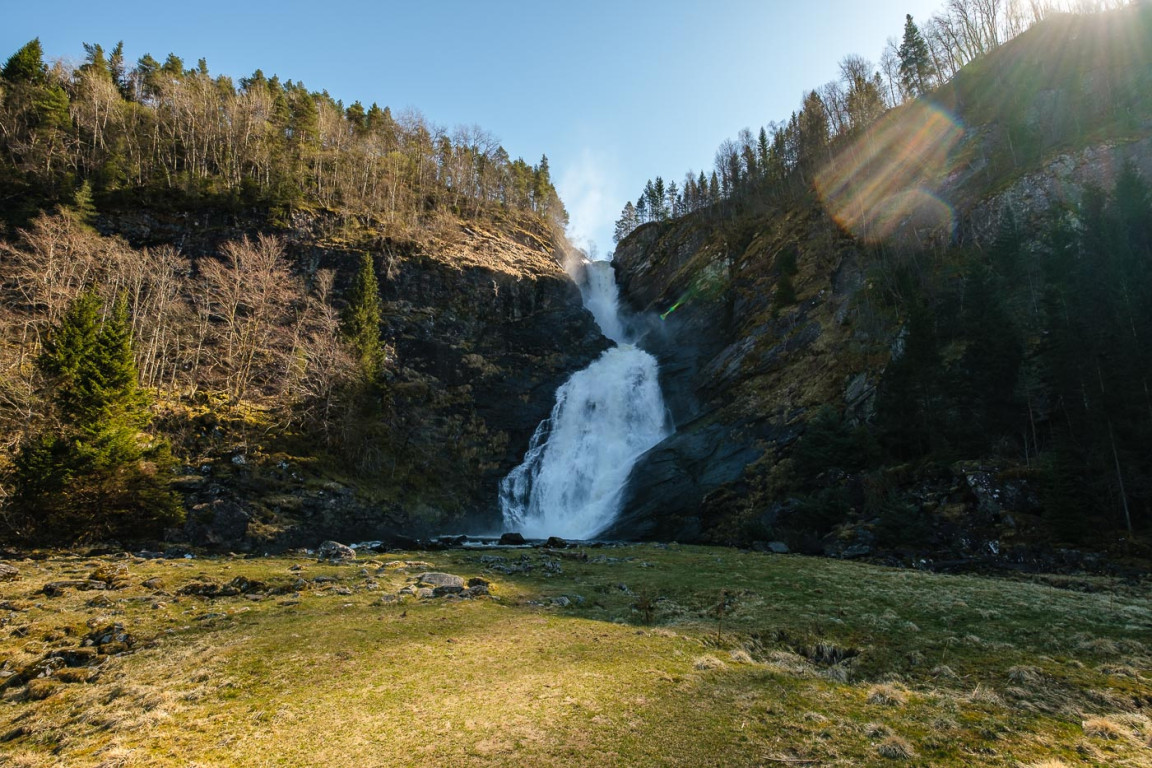
While in Olden, don’t miss the opportunity to take a scenic drive around Lake Olden, as we did it. Along the route, you’ll encounter breathtaking waterfalls, such as Eikelandsfossen and Huldefossen, where you can pause to admire their cascading beauty and snap some memorable photos.
If time permits, consider exploring the Olden village itself. Visit the charming Olden Church, a small wooden church with a rich history, or take a leisurely stroll along the shores of Lake Olden, soaking in the tranquillity of the surroundings.

We still had time, for a trail at the end of the day. The Rakssetra Trail in Loen is a breathtaking hiking route that offers stunning views of the surrounding Norwegian landscapes. This trail takes you through picturesque valleys, lush forests, and open meadows, providing an immersive experience in nature.
The trail starts at the base of Mount Hoven and gradually ascends through the enchanting Raksdalen Valley. The parking space costs around 70NOK (6€). As you hike along the well-marked path, you’ll be surrounded by towering mountains and the soothing sound of cascading waterfalls.
One of the highlights of the Rakssetra Trail is the opportunity to visit Rakssetra, a traditional mountain farm nestled in the valley. Later, we discover this mountain pasture is abandoned and currently used by those who own it. But, you can enjoy the great view down to the fjord, Olden and the Oldedalen Valley.
Continuing on the trail, you’ll be treated to panoramic vistas of the majestic Jostedalsbreen National Park and the glimmering waters of Lovatnet Lake. The ever-changing scenery, from lush greenery to rocky outcrops, creates a dynamic and captivating hiking experience.
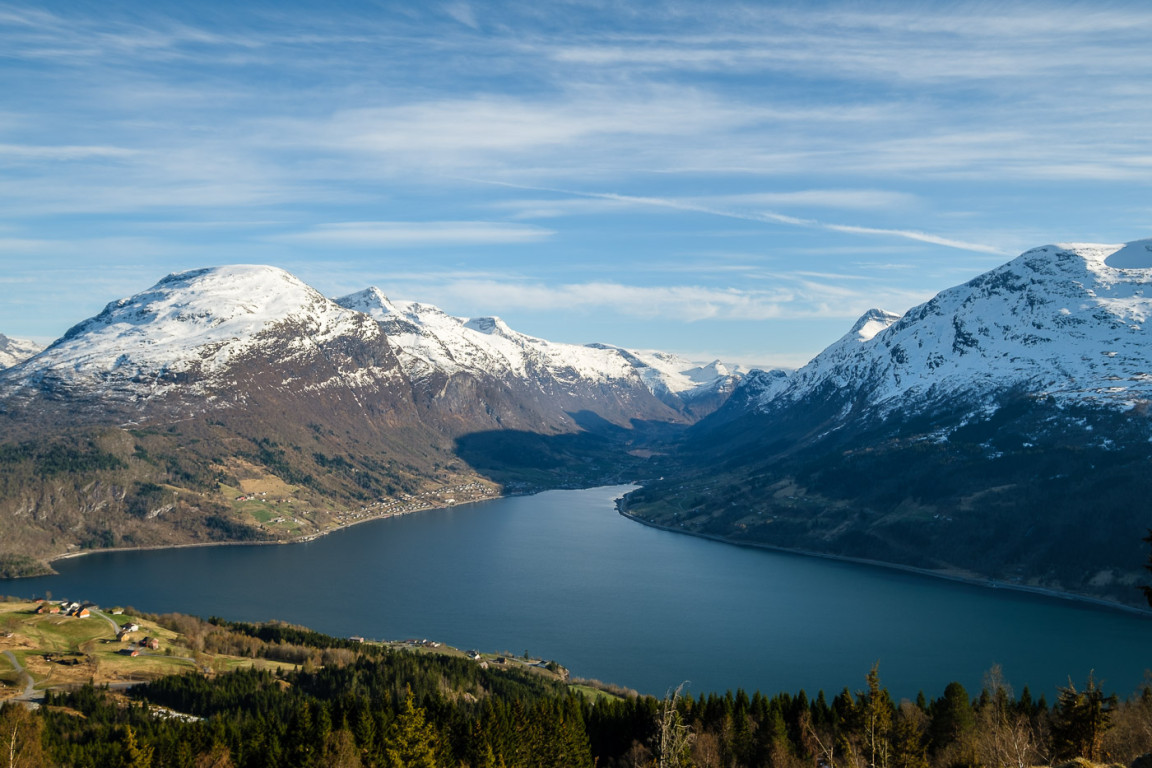
The Rakssetra Trail is of moderate difficulty, making it suitable for hikers of various fitness levels. The total distance of the trail is approximately 9 kilometers (5.6 miles), and it typically takes around 3 to 4 hours to complete, depending on your pace and the time spent enjoying the surroundings.
It’s advisable to come prepared with sturdy footwear, a sufficient water supply, and snacks or a packed lunch. As always, it’s important to follow Leave No Trace principles and respect the natural environment by not littering and staying on designated trails. We find it with some snow at the top but, it was good to go.
Whether you’re a nature enthusiast, a photography lover, or simply seeking a peaceful escape, the Rakssetra Trail in Loen promises an unforgettable hiking adventure filled with awe-inspiring views and a deep connection with Norway’s pristine wilderness.
Exploring Briksdalsbreen Glacier
One of the must-visit destinations on our eco-friendly itinerary in Norway is the magnificent Briksdalsbreen Glacier. This awe-inspiring natural wonder, located near the village of Olden, offers a unique opportunity to witness the power and beauty of a glacier up close.

We really recommend staying in Olden or nearby for this activity. Reaching the Briksdalsbreen Glacier is easy if you have a rental car, like us. But, you can also choose a scenic bus ride from Olden. These buses are eco-friendly and provide convenient transportation to the glacier. Alternatively, you can embark on a scenic hike from Olden to the glacier if you prefer a more active approach. The hiking trail offers stunning views of the surrounding landscapes and allows you to immerse yourself in the natural beauty of the region.

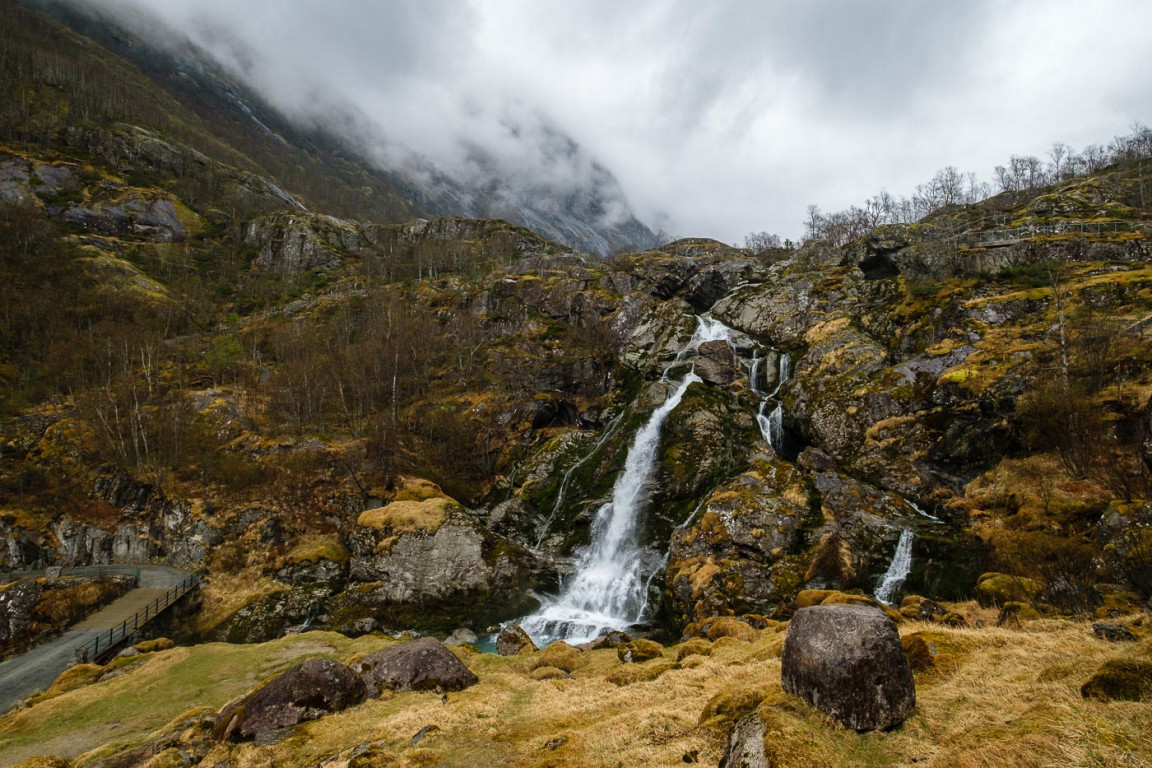
Briksdalsbreen, also known as Briksdal, is one of the most accessible and best-known arms of the Jostedalsbreen glacier. The trail is 3km and takes about 45 minutes each way. You can also do the 3 Glacier Hike and see the Melkevoll and Brenndal Glaciers in addition to the Briksdal Glacier.
There is parking on the Mountain Lodge and it’s where the trail start. The hike is just as amazing as the glacier. Along the trail, you will find, wild rivers, waterfalls, mountains and wildlife, that conclude in a viewpoint at the glacier lake. Seeing a small fraction of the glacier is a mixed emotion, mainly because Briksdalsbreen is retreating rapidly and losing mass like many other glaciers in Norway. This is so sad, visible evidence of climate change and unless we do something it will disappear.
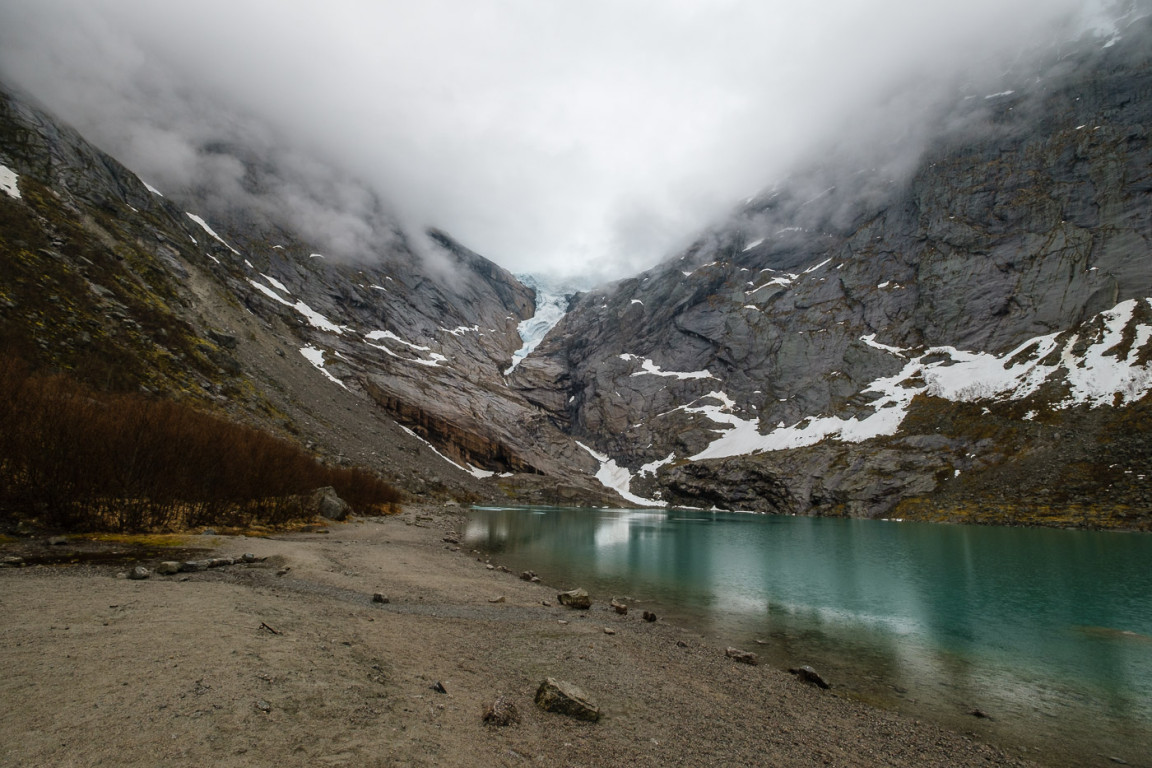
As Briksdalsbreen is a popular place, you can find a fun way to go to the glacier, ‘troll cars’. It can fit 7 people and stop just nearby the viewpoint at the glacier lake. You still have to walk a few meters.
Take your time at the glacier, and appreciate the natural beauty because one day your children may no longer see this.
Geiranger Fjord
One of the highlights of our eco-friendly itinerary in Norway was the ferry crossing through the majestic Geiranger Fjords. This extraordinary journey takes you through some of the most breathtaking landscapes in the country, offering unparalleled views of cascading waterfalls, steep cliffs, and serene blue waters.
It is advisable to buy the tickets to the ferry and this is an exception that is not included when renting a car. The Geiranger Fjord is very tourist, special in summer, they only sell a few spots on the ferry and tickets will go fast. We got lucky, as there weren’t many people.

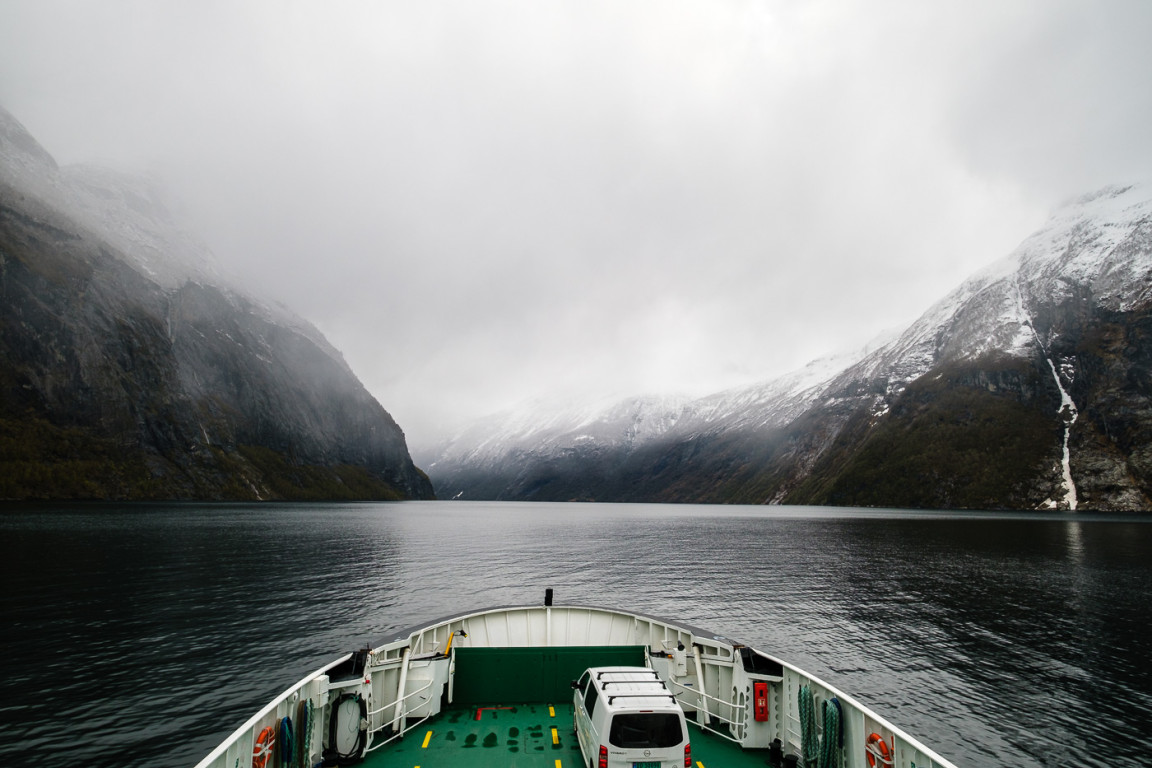
The ferry crossing begins at the charming village of Hellesylt, situated at the head of the UNESCO-listed Geiranger Fjord. Hellesylt is renowned for its picturesque setting, surrounded by lush green mountains and gushing waterfalls. As you board the ferry, find a comfortable spot on the deck and prepare to immerse yourself in the beauty of the fjord.
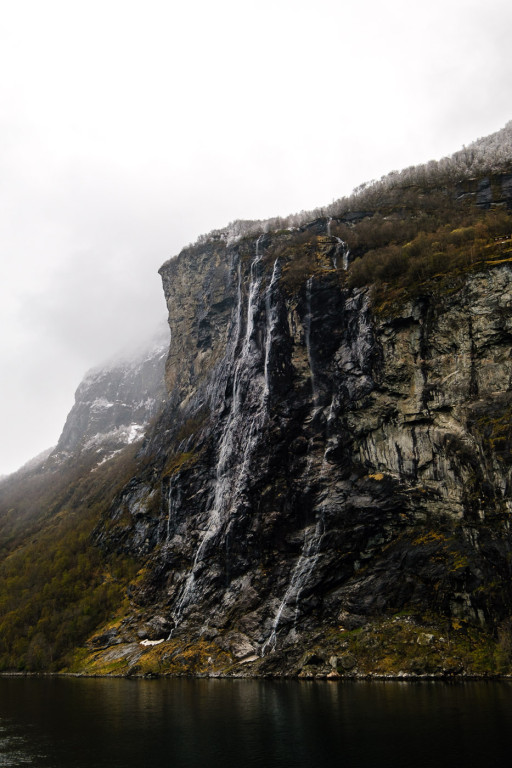

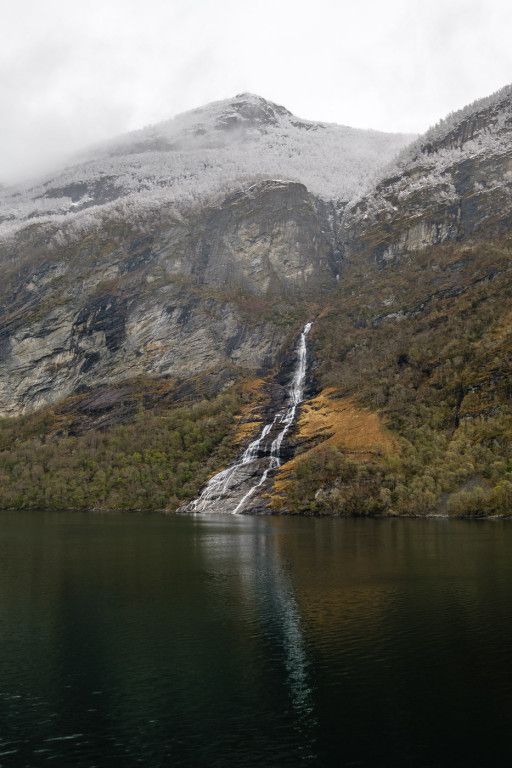
As the ferry sets sail, you’ll be treated to breathtaking views of the Geiranger Fjord’s steep cliffs, carved by ancient glaciers. We keep the camera handy, as around every corner, we encounter captivating waterfalls that cascade down the mountainsides. The most famous of these is the Seven Sisters waterfall, where seven distinct streams of water flow side by side. It’s a truly mesmerizing sight and a photographer’s dream but, at the time of our visit, there wasn’t much water flow.

As we reach the end of the ferry journey, we arrive at the charming village of Geiranger, nestled at the heart of the fjord. Geiranger is known for its quaint wooden houses, vibrant floral gardens, and warm hospitality. We take some time to explore the village, visit some local shops, and enjoy a leisurely stroll along the waterfront.
If you still had time, we recommend a visit to the Geiranger Skywalk. The place offers panoramic views of the fjord and the surrounding mountains.
Trollstigen
As we said before, in Norway is necessary to check the road before going. For one of the most famous scenic roads, Trollstigen, it was a no because it was closed. Trollstigen is only accessible during the summer months, typically from late May to October, due to the challenging weather conditions and road closures in winter. Nonetheless, we still want to go as far as we can, and also explore the neighbourhood, Gudbrandsjuvet.
Leaving Geiranger to Trollstigen, this itinerary showcases the dramatic beauty of the Norwegian countryside, offering breathtaking vistas and unforgettable moments along the way.

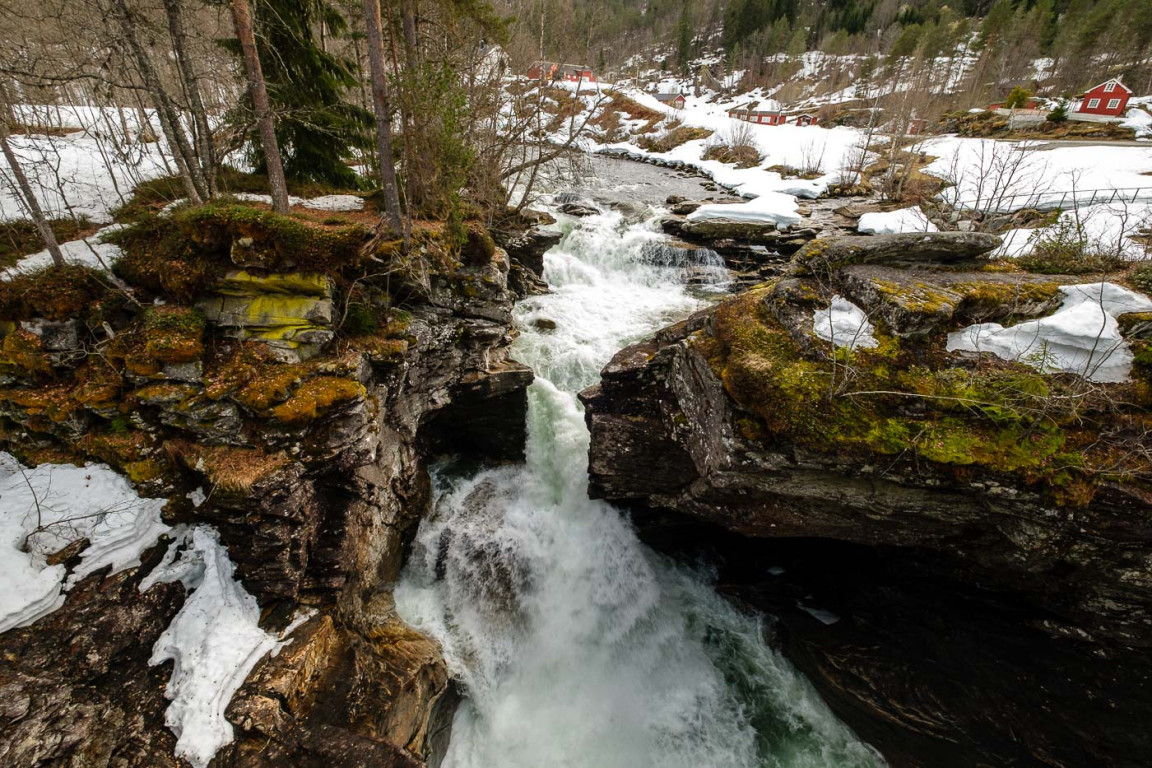
Reaching Gudbrandsjuvet was a joy and as a bonus, it seems we were the only ones there. This stunning gorge, with its narrow ravine and cascading waterfalls, serves as a reminder of nature’s raw power and beauty. The raw power of water was on full display, and it was a sight that left us in awe.
We still drive a few meters ahead to the beginning of the Trollstigen, but then the road was closed. There was so much snow at the time, it was really impressive. Even though it was close, the place and surrounding environment were stunning. We stay there a long time, just appreciating the beauty of nature. Our world has so many fascinating places.

If you are doing Trollstigen in the summer, take some time to explore the area on foot. Follow the well-marked paths and hiking trails that lead you to viewpoints offering panoramic vistas of the surrounding mountains and valleys. Marvel at the cascading waterfalls, breathe in the crisp mountain air, and let the tranquillity of the landscape envelop you.
Trollstigen is also a gateway to Romsdal, a region known for its stunning natural beauty and outdoor recreational opportunities. Consider extending your stay to explore the nearby attractions, such as the Romsdalseggen Ridge hike, the charming town of Andalsnes, or the dramatic peaks of the Romsdal Alps.
Olden to Voss
On our journey from Olden to Voss, we were treated to a spectacular route that showcases some of Norway’s most stunning natural and cultural attractions. Prepare yourself to be captivated by the beauty of the Boyabreen Glacier, the charm of historic stave churches, the engineering marvel of the Laerdal Tunnel, and the breathtaking views from the Stegastein viewpoint.

These of the main spots of our road trip day. We were cautious to prepare it because we didn’t want to spend much time on the road. Be aware that in Norway, distances from one locality to another are normally considerable.
The first stop was at Boyabreen Glacier. Located in Jostedalsbreen National Park, the Boyabreen Glacier is a mesmerizing icy wonder. As you approach the glacier, you’ll witness its impressive size and the striking blue hues of the ice. Although, he is much smaller than a few years ago.

Boyabreen is one of the most easily accessible glaciers in Norway. From time to time, you can see an icefall, as large blocks of ice break off from the edge and roll down the slope with a rumble.
There is a parking nearby, and you can walk a few meters to the glacier. At the time of our visit, there was a lot of snow, we did park the car but, didn’t walk to the glacial lake. Just 5 minutes drive and if you have time, visit the Norwegian Glacier Museum in Fjaerland.
Stave Churches
On our journey from Olden to Voss we visit two of the most gorgeous stave churches. Stave churches hold a special place in Norway’s architectural and cultural heritage. These unique wooden structures, characterized by their intricate designs and ancient craftsmanship, offer a glimpse into the country’s rich history.
They were primarily built during the Middle Ages and showcase a distinctive architectural style, blending Christian influences with Viking-era traditions. The churches are constructed using a technique known as stave construction, where large vertical wooden posts (staves) support the weight of the building. Intricate carvings adorn the exterior and interior, featuring intricate patterns, dragon motifs, and religious symbols.

Stave churches serve as tangible links to Norway’s past, offering insight into the country’s cultural and religious evolution. They stand as testaments to the resilience and craftsmanship of medieval Norwegian society, enduring centuries of change and upheaval. Visiting these churches allows us to connect with the country’s history and experience a sense of reverence in their sacred spaces.
The first stave church we visited was Kaupanger Stave Church. Nestled on the shores of Sognefjorden, the Kaupanger Stave Church is a medieval wooden masterpiece. Dating back to the 12th century, this well-preserved stave church is an architectural gem. The church has the largest number of staves to be found in any one stave church. We admire the intricate woodwork, the charming dragon carvings, and the peaceful ambience of this cultural heritage site.

Not so far, there is Borgund Stave Church, one of the most famous in the country. This iconic stave church, built in the 12th century, is one of the best-preserved examples in Norway. The exterior is adorned with intricate carvings of intertwining dragons, vine-like patterns, and Christian symbols, displaying the exceptional craftsmanship of the era. The elegant and symmetrical design, with its steep rooflines and dragon-head gables, exudes an air of both strength and grace
We didn’t have the opportunity to step inside. But we read that entering Borgund Stave Church is like entering a time capsule. The wooden walls, adorned with medieval paintings and religious artifacts, offer glimpses into the spiritual life of the past. There is a central nave, flanked by sturdy wooden columns, which leads to the high altar, creating a sense of sacred procession.


Borgund Stave Church has a unique feature right next to the church, a free-standing stave-work bell tower. It is Norway’s only remaining free-standing stave-work bell tower.
Stave churches have inspired numerous legends and folklore throughout the years. One popular tale involves the construction of the Borgund Stave Church, where it is said that supernatural beings helped the builders work through the night, leading to its completion in an astonishingly short time.
After visiting beautiful stave churches, we went to a special tunnel. As you traverse from Aurlandsfjorden to Laerdal, you’ll pass through the Laerdal Tunnel, a marvel of modern engineering. This tunnel, stretching over 24 kilometres, is the longest road tunnel in the world.
Because of the potential of rock falls in the area and the rough terrain, it was decided to construct a tunnel rather than repair existing roadways. The tunnel was considered to be an environmentally responsible investment because it prevented the destruction of undeveloped natural areas of the terrain. This is now part of an essential extension of a safe, ferry-free road link between Norway’s two biggest cities.
The 20 minutes trip inside the tunnel it’s anything but monotonous. It’s a unique experience of travelling through the beautifully illuminated tunnel with colourful lights, creating a captivating visual.
Norwegians are serious about safety. They have in many places road radars to control speed, and people did have attention to this. They are careful to drive. So, in a tunnel, you can expect safe measures at its highest. It’s really a great experience to cross Laerdal Tunnel, so if you are going to Norway had it to your itinerary.

After, such a long drive we went for more adventures. There is a popular spot where you can admire the Aurlandsfjord just outside the tunnel. Stegastein’s viewpoint has breathtaking views.
Perched high above Aurlandsfjorden, this architectural marvel offers panoramic vistas of the fjord and surrounding mountains. The dramatic, glass-floored platform provides an exhilarating perspective of the steep cliffs and shimmering waters below.

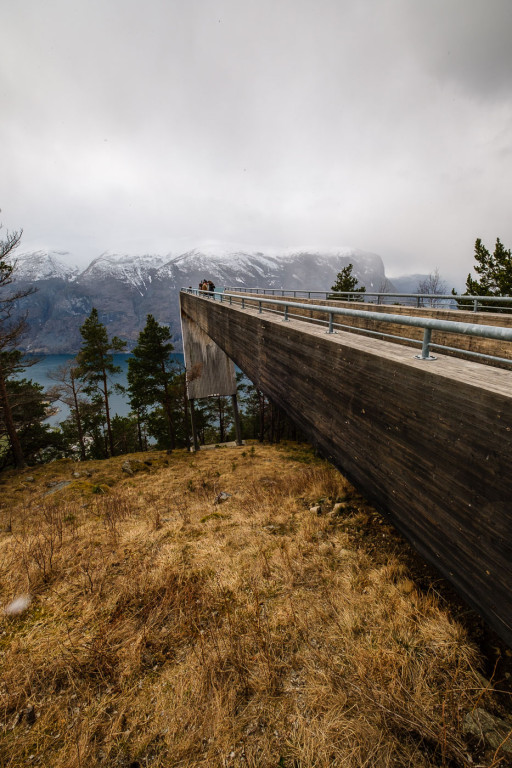
To reach the viewpoint you will have to go through a mountain road not so well maintained. At the time we even thought the road was closed. But, after a long winter that made some damage, the road is being repaired for summertime.
Following our adventure from Stegastein’s viewpoint, we had to reach Voss before getting darker and didn’t have so much time to stop at other places.
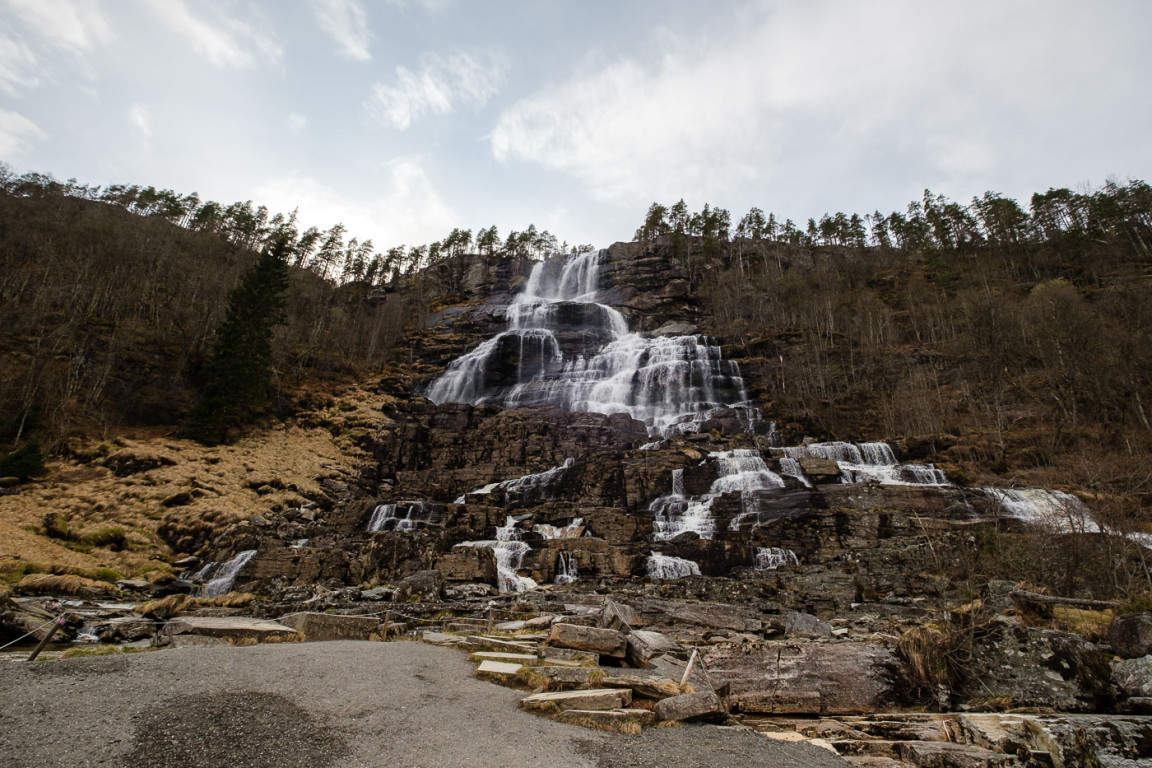
En route to Voss, we made a quick stop at the enchanting Tvindefossen Waterfall. Cascading down a height of 110 meters, this majestic waterfall captivates with its sheer power and natural beauty.
A good local to Immerse yourself in the tranquillity of the surroundings and feel the mist on your face as you witness the force of nature in action. It was one of our favourites place on the day.
Voss to Jorpeland
We stayed for the night at Voss, because driving in Norway can be really tiring. Resting in one of the oldest hotels in Norway, Fleischer Hotel, in just a history himself inside.
The next morning, we were refreshed and ready to embark on the journey from Voss to Jorpeland. The purpose was to stay for the night and then hike Pulpit Rock. On this journey, we encounter awe-inspiring landscapes and cultural gems. From majestic waterfalls to marvelling at engineering, we still had time to hike the picturesque Husedalen 4 Waterfalls Trail. Let’s take a closer look at each attraction along this eco-friendly itinerary in Norway.

The first stop after we got out of Voss, was Skjervefossen Waterfall. This stunning waterfall is nestled amidst the captivating Norwegian countryside. It was the perfect way to start the day, immersing ourselves in nature.
The waterfall can be seen both from above and from ground level. At its top, there is a free parking lot and toilets. We witness the cascading waters plunge into the crystal-clear pool below. The first ray light of the morning hitting the water created a double rainbow, it was a memorable moment.
The waterfall was at full power, and with so much water flowing, we take a moment to appreciate the raw power and beauty of this natural wonder.
Continuing our journey, we end up passing a series of impressive tunnels. They even got a roundabout inside, that was insane. Just right after the last tunnel, we fell into the Hardanger Bridge.
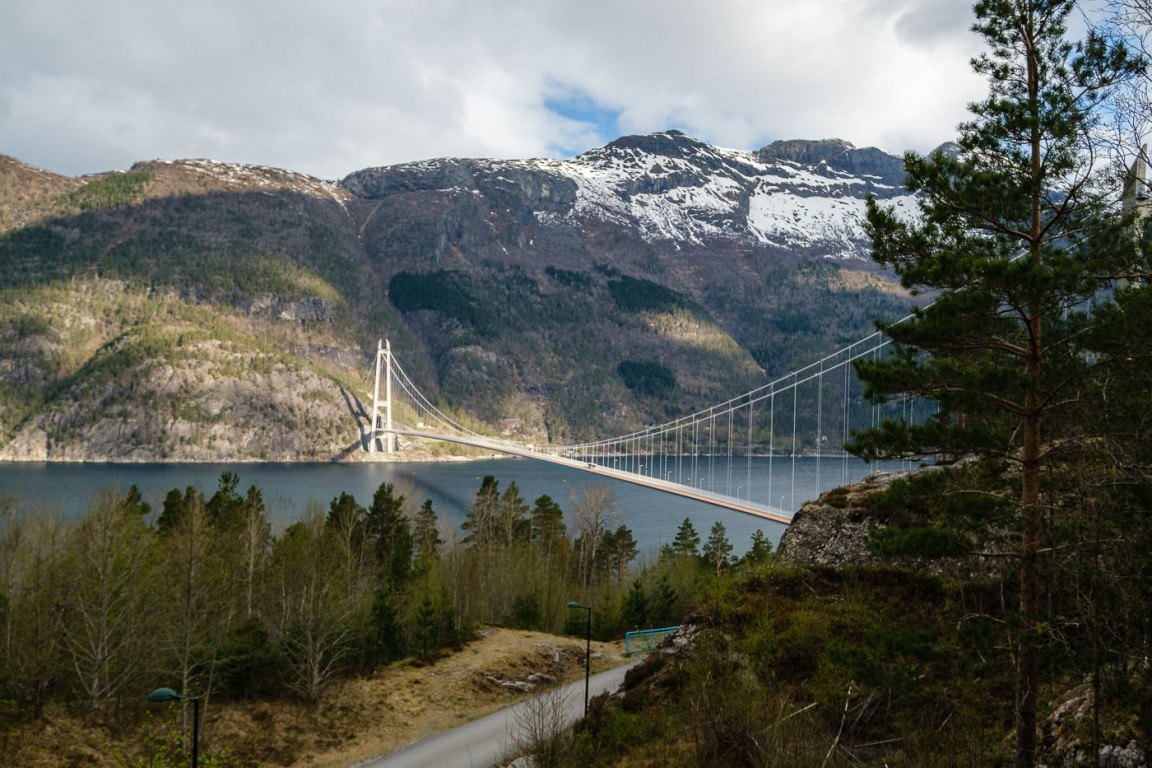
Spanning the tranquil waters of the Hardangerfjord, this suspension bridge offers breathtaking views of the surrounding fjord and mountains. On the exit of the bridge we stop at a viewpoint, pause to capture the picturesque scenery and embrace the sense of awe that this architectural masterpiece inspires.
One of the country’s most famous waterfalls is Voringfossen, which will feature in our eco-friendly itinerary in Norway.
Nestled in the heart of the stunning Hardangervidda plateau in Norway, Voringfossen is a magnificent waterfall that captivates visitors with its sheer beauty and dramatic setting. Plummeting down a sheer drop of 182 meters, this cascading waterfall is a sight to behold and a must-visit destination for nature enthusiasts and adventure seekers alike.
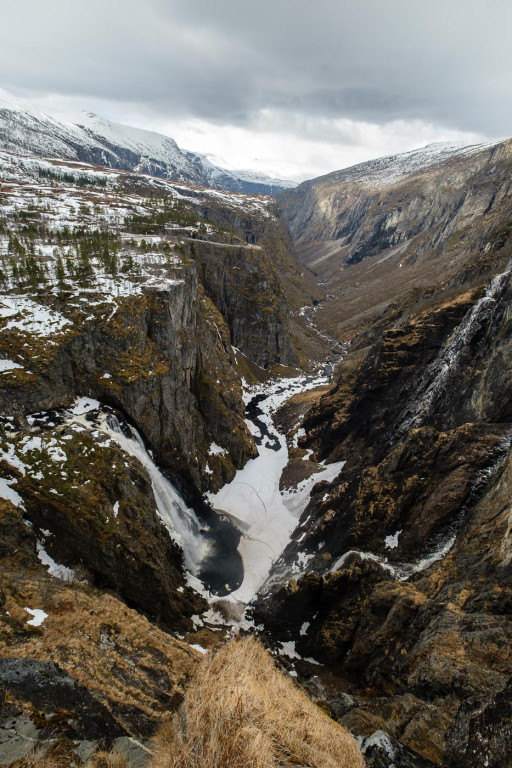
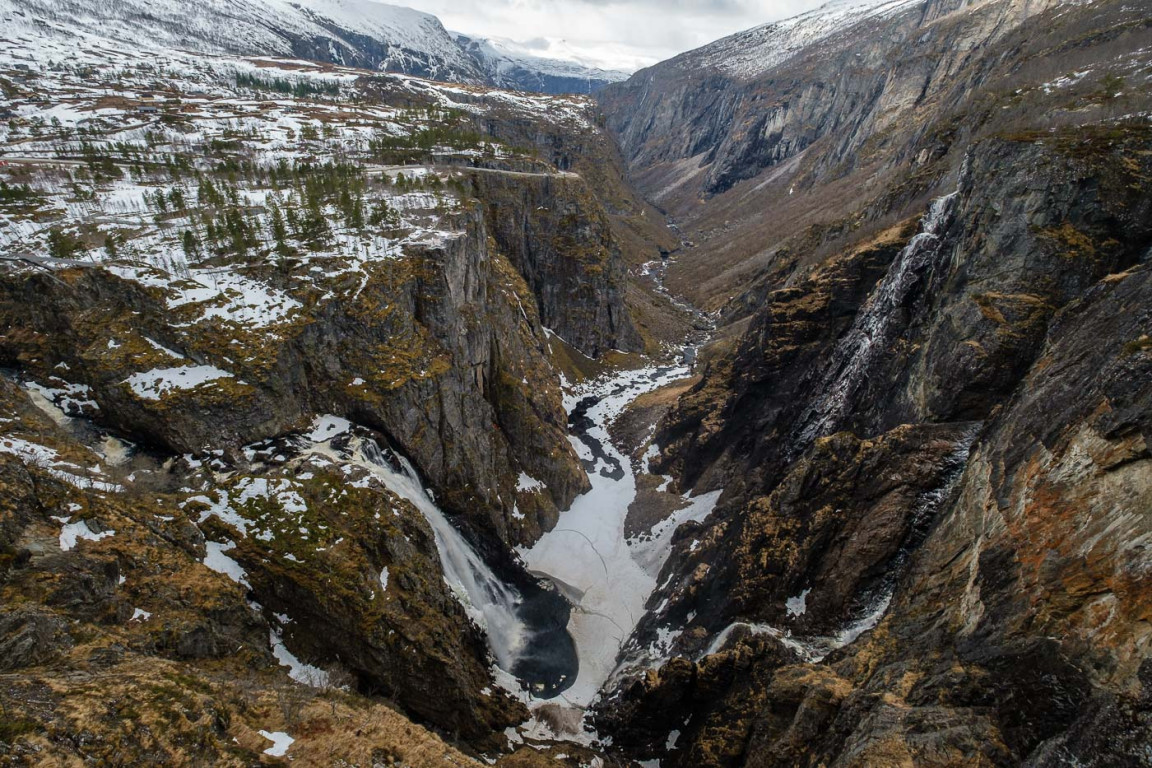
The force of the water creates a mesmerizing spectacle, as the falls create a thunderous roar and send up sprays of mist that catch the light, creating rainbows on sunny days. The surrounding rugged cliffs and lush greenery add to the dramatic charm of the scene, making Voringfossen a photographer’s dream.
To access the local you just need to leave your vehicle in the parking and walk. Today, modern infrastructure and well-maintained viewpoints make it more accessible, allowing visitors to marvel at this natural wonder with greater ease.
At the time of our visit, there was still snow everywhere, making the scenery superb. Even though this, the waterfall was quite powerful. Because of the snow, there was a high risk of fall and we didn’t explore the several platforms and pathways. These infrastructures allow you to appreciate its grandeur up close. Interpretive signage along the trails provides information about the geological and cultural aspects of the area, adding educational value to your visit.
Voringfossen is a testament to the raw power and breathtaking beauty of nature. Probably one of the most surreal waterfalls in Norway.
Just before reaching Jorpeland, we made a quick stop at the historic Roldal Stave Church. This well-preserved stave church dates back to the 13th century and holds great cultural and religious significance. We admired the intricate wood carvings in the exterior but, didn’t step inside.
This stave church is known for its crucifix, which according to legend has healing powers, as it sweats once a year on “Olsok” (6th july after the Julian calendar).
Husedalen 4 Waterfalls Trail
Nature lovers will be delighted by the Husedalen 4 Waterfalls Trail, a scenic hiking route that meanders through breathtaking landscapes. Immerse yourself in the tranquillity of the lush forests, as you encounter four magnificent waterfalls along the way: Tveitafossen, Nykkjesoyfossen, Nyastolfossen, and Sotefossen. Each waterfall offers its unique charm and photographic opportunities.
Located in the stunning Hardanger region, this trail takes you on a mesmerizing journey through lush forests and along roaring rivers.
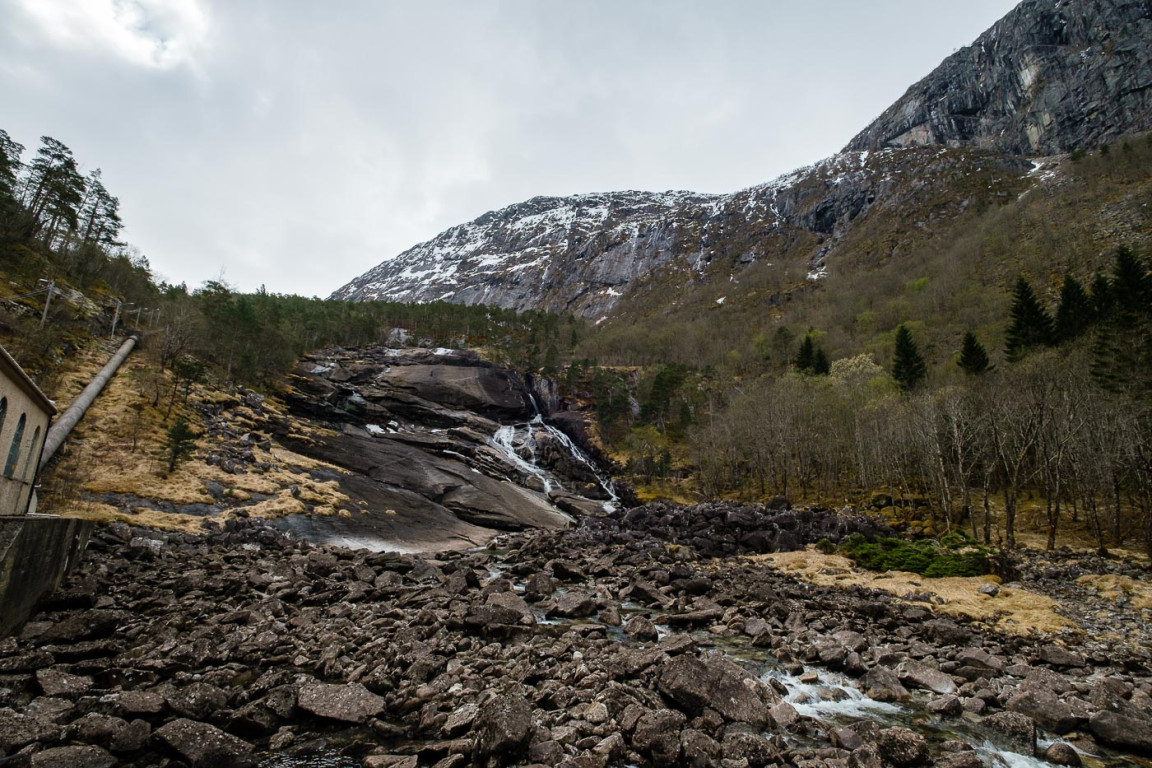
We actually didn’t start early in the morning, but as the trail marked 4/6 hours round trip, it was good. Marked as a challenging trail, we didn’t think it was. But, be aware of your physical condition, some parts are demanding and steep, slippery when wet. The hiking starts at the parking space, where you can go along the gravel road to the first waterfall.
Tveitafossen enchants visitors with its graceful cascade. Surrounded by verdant vegetation, the water plunges down a rocky ledge, creating a display of natural beauty. The tranquil pool at the base of the waterfall provides a perfect spot to pause, soak in the scenery, and appreciate the raw power of nature. At the time of our visit, there wasn’t much water flow, so left us a little bit disappointed.


Continuing along the trail, you’ll come across Nykkjesoyfossen, a hidden gem tucked away amidst the serene Norwegian wilderness. This waterfall boasts a distinctive fan-like shape as the water gracefully cascades down multiple tiers. The peaceful atmosphere surrounding Nykkjesoyfossen invites you to sit and marvel at the enchanting scene. That’s what we did, after climbing a little bit behind the power station, we had to rest for a moment.
Nyastolfossen awaits as the next waterfall on the trail, captivating hikers with its powerful torrent of water. Plunging down a steep rock face, the falls create a majestic spectacle that reverberates through the surroundings. The spray from the waterfall adds a refreshing mist to the air, invigorating your senses as you witness nature’s raw energy. At this level there was still much snow, so we didn’t think was safe to go through the last waterfall.
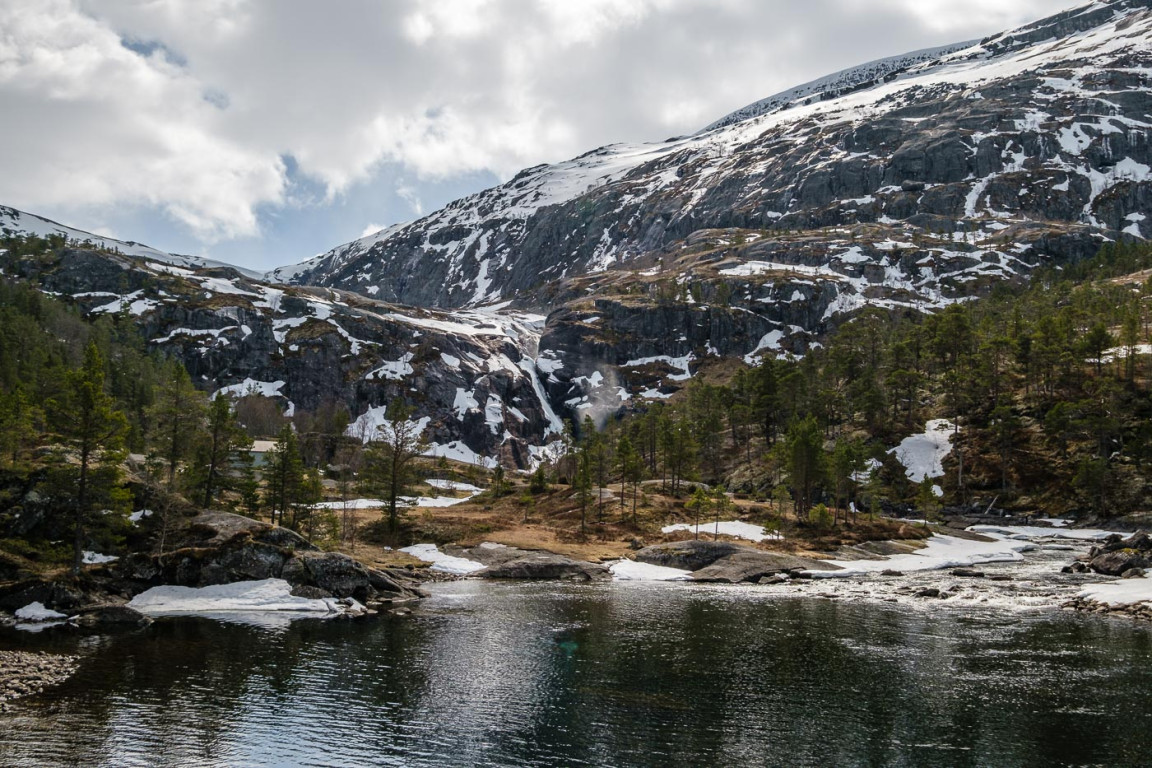
The final waterfall on the Husedalen trail is Sotefossen. We didn’t go but, we read this majestic waterfall drops in a series of cascades, creating a mesmerizing sight and a symphony of rushing water.
We did like a lot of this hiking trail. It offers a mix of natural beauty, well-maintained paths, and occasional wooden bridges that allow you to traverse the varied terrain. The trail winds through lush forests, alongside crystal-clear rivers, and offers stunning vistas of the surrounding mountains.
Hiking the Husedalen 4 Waterfalls Trail provides an opportunity to connect with nature on a profound level. In most of the parts, we were completely alone.
Pulpit Rock
One of the most iconic and exhilarating hikes in Norway is the trek to Pulpit Rock, also known as Preikestolen. As we planned our eco-friendly itinerary in Norway we really focus on this part of the trip.
This stunning cliffside formation, towering 604 meters above the Lysefjord, offers breathtaking panoramic views and a true sense of adventure. Pulpit Rock is so popular that has been used as a filming location for major film productions, like Mission Impossible.
We started early in the morning to go for Pulpit Rock but the weather was bad when we got to the location. There is parking nearby and you can park for the day or a limited time, as we did, waiting for the weather to get better. Unfortunately, it got even worse, it started to snow. Sometimes, you just have to be smart, it wasn’t safe so we gave up.
Anyway, here’s a brief description of the hike and some essential tips to make the most of your Pulpit Rock experience.
Distance: 7.6 km (4.7 miles) out-and-back
Elevation Gain: 350 meters (1150 feet)
Difficulty: Moderate
Length of Time: 4 to 5 hours
When to Go: All year round. If you plan to do this hike in the off-season (November through April), always check the information.
The Pulpit Rock hike starts from the trailhead near the village of Preikestolen, which is easily accessible from Stavanger. We choose to stay in Jorpeland, 10/15 minutes by car to the parking of Pulpit Rock.
The well-marked trail takes you through diverse landscapes, including forests, rocky terrain, and open plateaus. As you ascend, the trail gradually becomes steeper, presenting a moderate challenge for hikers. However, the rewarding views awaiting you at the top make every step worthwhile.
Upon reaching the summit, you’ll be greeted by the awe-inspiring sight of Pulpit Rock, a flat, rectangular plateau perched precipitously on the edge of a sheer cliff. From this vantage point, you can marvel at the vastness of the Lysefjord below, surrounded by towering mountains and cascading waterfalls. The panoramic vista is truly a sight to behold and offers a sense of tranquillity and wonder.
Tips for Hiking the Pulpit Rock Responsibly:
- Plan your visit: Check the weather conditions and plan your hike accordingly. It’s best to attempt hiking during the summer months when the trail is accessible and the weather is more favourable. Start early in the day to avoid crowds and allow ample time to enjoy the views.
- Dress appropriately: Wear comfortable hiking shoes and dress in layers, as the weather can change quickly. Bring a windproof and waterproof jacket to protect against sudden changes in weather conditions.
- Pack essentials: Carry enough water to stay hydrated throughout the hike, as no water sources are along the trail. Pack snacks or a picnic lunch to enjoy at the summit. Don’t forget sunscreen, a hat, and insect repellent.
- Stay on the designated path: Stick to the marked trail and avoid venturing too close to the cliff’s edge for your safety and to minimize your impact on the fragile vegetation.
- Leave no trace: Preserve the pristine nature of the area by packing out any trash and leaving the environment as you found it. Respect the flora and fauna, and do not disturb or remove any natural elements.
- Follow safety guidelines: Take note of any safety instructions or warnings provided along the trail. Be cautious on slippery or wet sections, and exercise care when navigating the rocky terrain.
Embarking on the Pulpit Rock hike is an adventure that showcases Norway’s stunning natural beauty and offers a sense of accomplishment. By hiking responsibly and following these tips, you can have a memorable and eco-friendly experience while respecting the fragile environment surrounding this remarkable natural landmark.
Also, don’t forget to book insurance to ensure you have all covered and your trip can be peaceful. We really think this is a must-have on any trip, even if you don’t have to use it.
Unfortunately, due to the bad weather, we couldn’t go but, next time we will be there.
Norway in a Nutshell
For those who don’t have much time, Norway in a Nutshell, can be an option. The “Norway in a Nutshell” itinerary is a journey that showcases the very best of Norway’s natural wonders. This carefully curated route takes you through breathtaking landscapes, from majestic fjords to snow-capped mountains, charming villages, and picturesque valleys.
The end our trip with a remarkable experience, we choose to take this self-made itinerary. You just need to book it and choose the route, length, and which activities to fit into your itinerary.
For us, the route was from Bergen to Oslo in 1 day. Our journey begins in Bergen, a vibrant coastal city known for its rich history and charming architecture. From Bergen, we boarded a scenic train that winds its way through lush valleys and towering mountains. As the train meanders along, you’ll be treated to breathtaking views of cascading waterfalls, serene lakes, and idyllic countryside.
After taking the train from Bergen, we arrived at Voss. Here we took the bus to Gudvangen, and reach the orange site saying ‘Voss station’, the bus number is 950. The scenic bus will take you through the enchanting Stalheimskleiva, a winding road with hairpin bends and stunning viewpoints. As you ascend and descend the narrow mountain road, you’ll be rewarded with panoramic views of the surrounding valleys and mountains.
Remember, this tour was self-guided there is no one to escort you but, along the way, you will find more people doing the same, so it was really easy.
The next stop was Gudvangen, where we catch the electric solar ferry through the fjord until Flam. The vessel is in carbon fibre and the design is inspired by a trail finding its way up a steep mountainside. A true engineering marvel, running silently on batteries along the fjords.


This breathtaking ferry journey through the UNESCO-listed Naeroyfjord, a narrow and picturesque fjord surrounded by steep mountains and cascading waterfalls was one of the highlights. The journey took some time, so we decided to have lunch on board and eat hot dogs. As the ferry glides along the tranquil waters, we took in the grandeur of the landscape and marvel at nature’s masterpiece. This fjord is considered one of the most beautiful in the world, and you’ll understand why as you witness its sheer beauty.
In Flam, a picturesque village nestled at the end of Aurlandsfjord, you’ll have the opportunity to explore the surroundings and immerse yourself in the tranquillity of the fjord. You can consider renting a kayak or joining a guided fjord cruise to get up close to the sparkling waters and towering cliffs. We opted for a visit to the Flam Railway Museum, it is free and an opportunity to know more about the construction of the line.
Later, we were transferred to the famous Flamsbana, one of the steepest standard-gauge railways in the world. This enchanting train ride takes you on an ascent through dramatic mountain scenery, passing by deep ravines, gushing rivers, and lush greenery. Keep your camera ready, as every turn reveals a new postcard-worthy view.
The train made a stop at Kjosfossen waterfall, but at this time of the year, was frozen. A few minutes later we arrived at Myrdal.
Situated in the mountainous region, Myrdal Station offers a unique blend of natural beauty and engineering marvels. Its strategic location makes it a crucial transportation hub, connecting the iconic Bergen Line with the Flam Railway. The station serves as a transfer point and it was here we took the famous Bergenbanen, one of Europe’s most beautiful train journeys.
It’s an immersive experience, the train winds its way to the Hardangervidda plateau, lush valleys and picturesque fjords. It allows travellers to witness the grandeur of Norway’s nature and embark on a memorable adventure through the heart of this remarkable country.
We arrived in Oslo at night, it was an exhausting day but, worth every second. For those who are considering doing ‘Norway in a Nutshell’, we recommend if you have time, doing in maybe 2 days and more activities along the way.
Oslo
To the final stop on your 10-day eco-friendly adventure in Norway, Oslo, the capital city and cultural hub of the country, was the choice.
We didn’t do much as take a stroll around the city. Staring headed to the Oslo Cathedral, a beautiful and historic church that is the main church for the Diocese of Oslo.
From there, we head over to the Norwegian Parliament building, also known as the Stortinget. Take a tour to learn about Norway’s political history and the role of the Stortinget in the country’s government. Actually, we tried to visit, as it was saturday and were supposed to have free tours but, everything was closed.
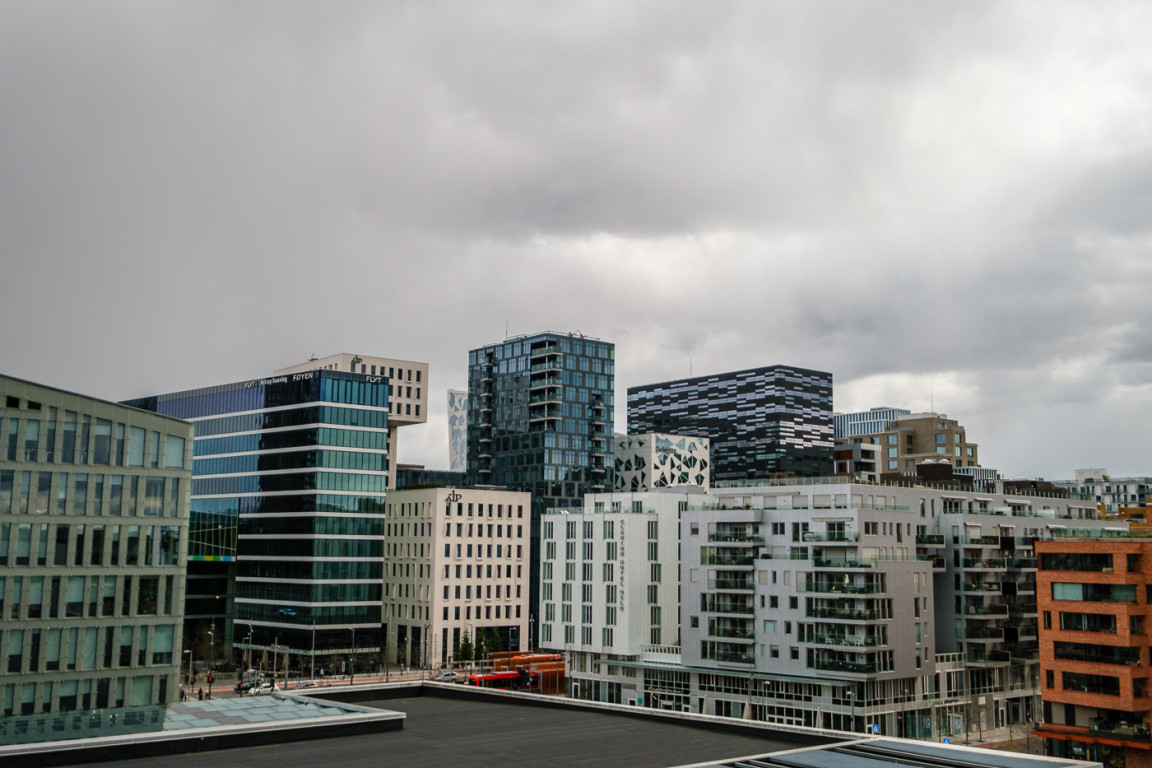
Afterwards, we continued to walk towards the Royal Palace. It is one of the most important buildings in the country and a concrete symbol of the course of Norwegian history since 1814. In the summer months, you can visit inside.
Constructed between 1931 and 1950 the Oslo City Hall is an impressive building and home to the city council. Although it says it’s open to the public every day (exceptions are special events) we couldn’t visit. Inside there’s a big hall, where the Nobel Peace Prize is handed out each year in December.
It was a good day, sun shining and good weather. So, we ended up walking along Oslo’s harbour promenade. There’s a food court, named Vippa where you can lunch for a good price.


Next, we make our way to the Akershus Fortress, a medieval castle and fortress that has protected Oslo since the 13th century. Exploring the grounds is free, take in the views of the harbour, and learn about the fortress’s history as a military stronghold.
Ending our day with a visit to the Oslo Opera House, a stunning modern building that is situated right on the waterfront. The Opera House offers free rooftop tours, which give visitors a unique perspective on the city and the surrounding fjord.
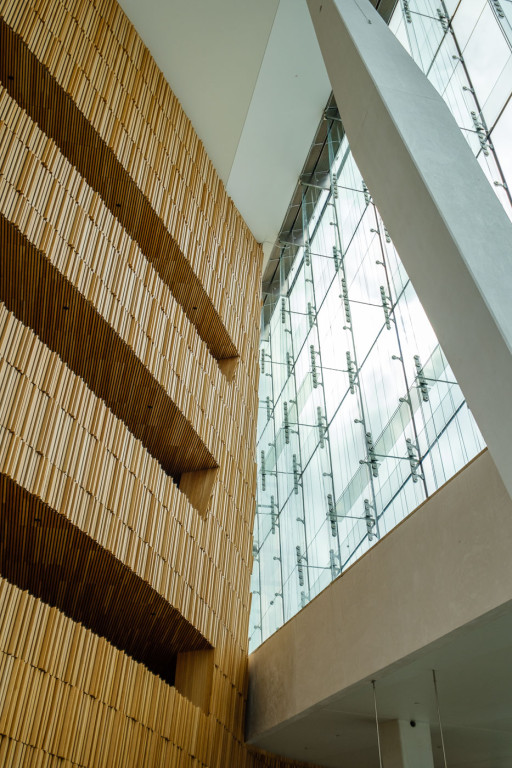
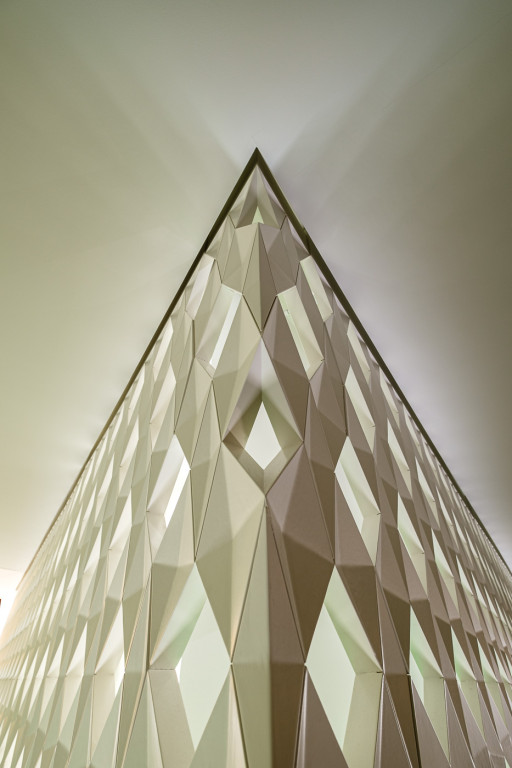

Nearby, you will have the Munch Museum, dedicated to the works of Norway’s most famous artist, Edvard Munch. This time we didn’t enter but, once inside you can admire the many works of art on display, including his famous painting “The Scream.”
There are a lot of things you can do in Oslo, never a dull moment in the capital. For more tours and things to do in the city check everything here.
In conclusion, this 10 eco-friendly itinerary in Norway offers a remarkable journey through a land of unparalleled natural beauty.
From the majestic fjords and cascading waterfalls to the snow-capped mountains and charming villages, Norway captivates the hearts of travellers with its awe-inspiring landscapes. This itinerary showcases not only the stunning sights but also the commitment to sustainable travel, allowing visitors to explore and appreciate the country’s natural wonders responsibly.
Whether hiking to glaciers, cruising through fjords, or immersing in cultural heritage, each day of this itinerary offers an opportunity to connect with the splendour of Norway and create memories that will last a lifetime. Embark on this eco-friendly adventure and discover the true essence of Norway, where nature reigns supreme and the beauty of the surroundings leaves an indelible mark on your soul.
